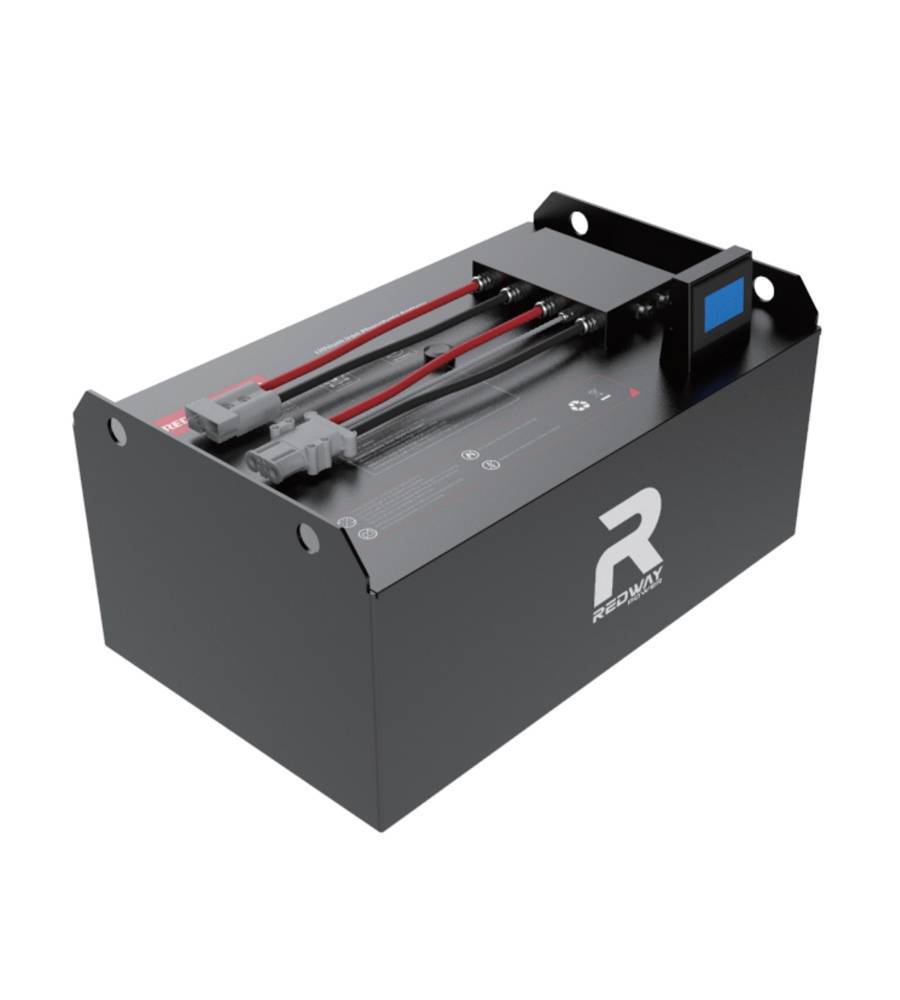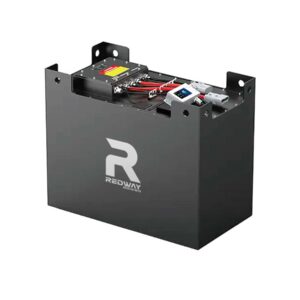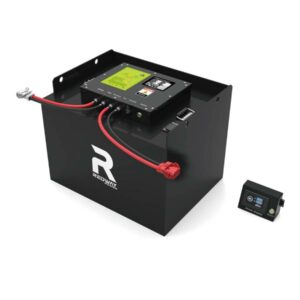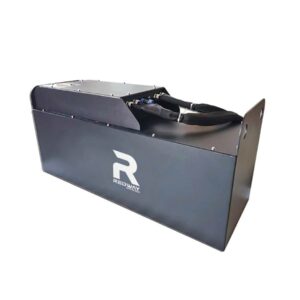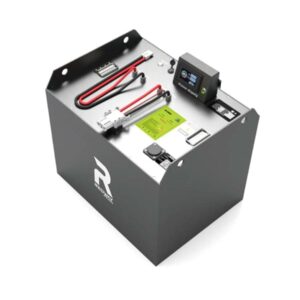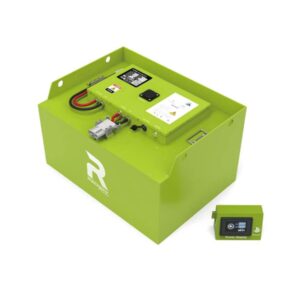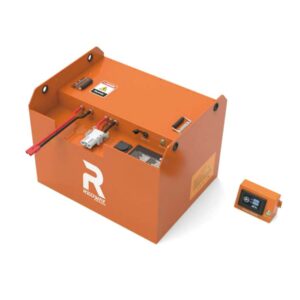Description
Our 48V 560Ah LiFePO4 Forklift Battery is a cutting-edge lithium power solution engineered for industrial excellence. As a leading lithium battery manufacturer, we specialize in delivering OEM-grade energy systems that optimize productivity, reduce operational costs, and support sustainable material handling workflows.
Key Features
Unmatched Energy Capacity: 48V/560Ah configuration delivers 28.67 kWh energy output, enabling uninterrupted 18+ hours of forklift operation per charge cycle.
Ultra-Durable Design: Engineered for 6,000+ cycles at 80% depth of discharge (DOD), tripling the lifespan of traditional lead-acid batteries.
High-Power Performance: Supports 400A continuous and 800A peak discharge currents for heavy-load handling in demanding warehouse environments.
Military-Grade Protection: IP67-rated metal casing ensures dustproof/waterproof durability, paired with a smart BMS that prevents overcharging, overheating, and short circuits.
Wide Compatibility: Operates seamlessly across 40V¨C58.4V systems, adaptable to Class I¨CIII forklifts without structural modifications.
Product Description
Designed for OEM integration, our 48V 560Ah LiFePO4 Forklift Battery combines advanced lithium iron phosphate technology with a compact footprint (950¡Á592¡Á450mm, 210kg). Its multi-layered BMS continuously monitors cell voltage, temperature, and current, ensuring 24/7 operational safety while extending service life. The battery excels in extreme temperatures (-20¡ãC to 60¡ãC), making it ideal for cold storage facilities and high-heat industrial zones.
Equipped with RS485/CAN-bus communication ports and an on-shell LCD display, it enables real-time fleet energy management and diagnostics. Modular construction allows rapid deployment across forklift models, minimizing downtime during upgrades.
Why Choose 48V 560Ah Lithium Forklift Batteries for Industrial Power?
48V 560Ah lithium forklift batteries deliver high energy capacity, long cycle life, and advanced safety features, enabling forklifts to operate longer with rapid charging and minimal maintenance. Their lightweight design and intelligent Battery Management System (BMS) optimize performance and reliability, making them ideal for demanding industrial environments focused on efficiency and sustainability.
What are the key technical specifications of 48V 560Ah lithium forklift batteries?
48V 560Ah lithium forklift batteries typically have a nominal voltage of 51.2V and an energy capacity of approximately 28.67 kWh. They support continuous discharge currents up to 400A and peak discharge currents up to 800A. Dimensions range around 830 x 630 x 627 mm to 950 x 634 x 784 mm, with weights between 210 kg and 610 kg depending on design and counterweights. The battery casing is robust, often rated IP65 for dust and water resistance. Cycle life exceeds 3500 to 4000 cycles at 80% depth of discharge, ensuring long-term durability.
How do 48V 560Ah lithium forklift batteries improve forklift performance?
These lithium batteries maintain stable voltage output without the voltage sag typical in lead-acid batteries, allowing forklifts to sustain speed and torque under load. Their reduced weight improves forklift maneuverability and reduces wear on components. Fast charging capabilities enable full recharge within 2 to 4 hours, minimizing downtime. High energy density extends operational hours, boosting productivity in warehouses and distribution centers.
What safety features do 48V 560Ah lithium forklift batteries include?
Equipped with an advanced Battery Management System (BMS), these batteries monitor voltage, current, temperature, and state of charge in real-time to prevent overcharge, over-discharge, short circuits, and overheating. The LiFePO4 chemistry provides thermal stability and eliminates acid leakage risks. Metal enclosures protect against physical damage, and certifications such as UN38.3, CE, and IEC ensure compliance with international safety standards.
How long is the cycle life and lifespan of these lithium batteries?
48V 560Ah lithium forklift batteries offer over 3500 to 4000 full charge-discharge cycles at 80% depth of discharge, translating to 8 to 10 years of service life under typical industrial conditions. This significantly outperforms lead-acid batteries, which generally last 1000 to 1500 cycles, reducing replacement frequency and total cost of ownership.
How are 48V 560Ah lithium forklift batteries charged and maintained?
These batteries support rapid charging protocols, typically requiring 2 to 4 hours for a full charge using compatible chargers. Maintenance is minimal since lithium batteries do not require watering or equalizing charges. Best practices include avoiding deep discharges, storing batteries at moderate temperatures (20-25°C), and conducting periodic inspections to maintain optimal performance.
Which industries and applications benefit most from 48V 560Ah lithium forklift batteries?
Industries with intensive material handling such as warehousing, manufacturing, cold storage, logistics, and distribution centers benefit greatly. These batteries enable longer shifts, reduce forklift downtime, and improve operational efficiency in environments demanding reliable, high-capacity power sources.
How do lithium forklift batteries compare to traditional lead-acid batteries?
Lithium forklift batteries offer higher energy density, longer cycle life, faster charging, and are maintenance-free compared to lead-acid batteries. Their reduced weight lowers forklift wear and improves handling. Lithium batteries eliminate acid spills and toxic emissions, enhancing workplace safety and environmental friendliness. Despite higher upfront costs, total cost of ownership is lower due to extended lifespan and reduced maintenance.
What communication and monitoring options do 48V 560Ah lithium forklift batteries provide?
These batteries feature CANBus and RS485 communication protocols for seamless integration with forklift monitoring systems. Optional 4G/LTE/GPS tracking enables real-time remote monitoring and diagnostics. Onboard LCD displays provide operators with immediate battery status, including voltage, current, state of charge, and fault alerts.
How does the Battery Management System (BMS) enhance safety and performance?
The BMS continuously monitors cell voltages, current, temperature, and state of charge, balancing cells to prevent overcharging or deep discharging. It protects against short circuits and thermal runaway, and provides real-time data for predictive maintenance. This intelligent system maximizes battery life, ensures safe operation, and optimizes energy usage under varying load conditions.
What environmental benefits do 48V 560Ah lithium forklift batteries offer?
These batteries reduce carbon emissions by enabling energy-efficient forklift operation and eliminating hazardous acid waste. Their long lifespan reduces battery replacements and waste generation. Additionally, lithium batteries are highly recyclable, supporting circular economy initiatives and aligning with corporate sustainability goals.
How does temperature affect the performance and durability of 48V 560Ah lithium forklift batteries?
Optimal operating temperatures range from -20°C to 60°C for discharge and 0°C to 55°C for charging. Extreme heat accelerates battery degradation, while very low temperatures temporarily reduce capacity. Advanced thermal management and insulation in battery design mitigate temperature effects, maintaining consistent performance and extending battery life.
Chart: Comparison of Lithium vs Lead-Acid Forklift Batteries
| Feature | Lithium (48V 560Ah) | Lead-Acid Battery |
|---|---|---|
| Nominal Voltage | 51.2V | 48V |
| Energy Capacity | ~28.67 kWh | ~20 kWh |
| Cycle Life | 3,500 – 4,000 cycles | 1,000 – 1,500 cycles |
| Weight | 210 – 610 kg | ~500+ kg |
| Charging Time | 2 – 4 hours | 8 – 12 hours |
| Maintenance | Minimal (no watering) | Regular watering required |
| Safety | Advanced BMS, sealed | Risk of acid spills |
| Environmental Impact | Recyclable, less toxic | Acid waste, higher emissions |
Chart: Battery Cycle Life vs Depth of Discharge (DoD)
| Depth of Discharge (%) | Cycle Life (approximate) |
|---|---|
| 30% | 4,000+ cycles |
| 50% | 3,500 cycles |
| 70% | 3,000 cycles |
| 80% | 3,500 cycles |

